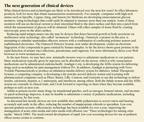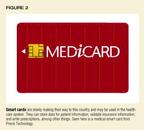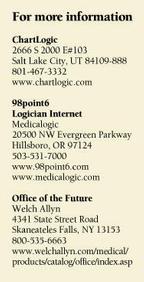Beyond 2000: Tomorrow's office technologies today
New technologiesthe electronic medical record, the smart healthcare card, web-based healthcare services, and integrated diagnostic devices will help pediatricians streamline their practices in the future.
Yesterday, today, and tomorrow
Beyond 2000: Tomorrow's office technologies today
By Andrew J. Schuman, MD
New technologies--the electronic medical record, the "smart" health-care card, Web-based health-care services, and integrated diagnostic devices--will help pediatricians streamline their practices in the future. Second of two parts.
Phew! It's time to unplug the generator, store the flashlights and batteries, and again consider flying to your next conference. I'd like to welcome all Y2K survivors to the last year of the millennium by peering into a crystal ball and sharing some nearsighted predictions concerning pediatric office technologies. Some likely clinical developments are reviewed in the accompanying box, "The next generation of clinical devices." Equally exciting are the evolving technologies for tracking findings and communicating with families and colleagues described below. Let's take a look at the practice of tomorrow.

A routine office visit
The year is 2005, and you are a young mother bringing your 4-year-old son to a popular pediatric practice in your community for his yearly well-child examination. Several weeks ago you received an e-mail message from your pediatrician indicating that your child was due for his physical, and you used your home computer and communications center to log on to the practice's Web site and schedule today's appointment.
You greet the receptionist, and as your child begins to play with toys in the waiting room, you sit down at the intake computer. You slide your medical card into the computer and place your fingertip on a sensor to confirm your identity. Your child's name appears on the screen, and you are asked to verify your current address and insurance information, using a stylus attached to the computer to check off answers to questions. After the confirmation screens, a dozen questions about your child's growth and development appear. How often does he eat? Does he know his colors? Any sleep problems? How high can he count? Is he toilet trained? You are then asked if you have any questions to discuss at this visit.
The computer thanks you for your answers and informs you that your child will be getting a nasal immunization today, in addition to a routine urine test. You knew about the urine test from the practice's Web page, and you brought a specimen with you.
Information about immunizations appears next, ending with a paragraph asking whether you accept the few risks associated with today's vaccine. You again confirm your identity via the fingerprint reader, and sign your name with the stylus to indicate consent.
The next screen lets you know that there will be a 10-minute wait before your child will be seen, and asks if you'd like to review some information on children's health. You pick several articles from a menu and download them to your medical card for review with your husband this evening.
The next menu asks if you need any forms for school or day care, and you respond that you would like an updated copy of your child's immunization record and also a health form and medication permission form for your son's day-care center. The computer screen indicates that these forms will be uploaded to your medical card at the end of the visit. With only five minutes left to wait you browse through some Internet sites developed by stores in your community and download several electronic "coupons" to your card for use later in the week.
The nurse summons you and your child to an examination room. Mounted on the desk in the far corner of the room is a small computer terminal with your son's medical record displayed on the screen. As the nurse measures his height and weight, the measurements appear on the screen.
The nurse inserts a probe into his ear, and the computer records his pulse rate, blood pressure, temperature, and hearing thresholds. After using a second probe, the nurse tells you that his recent ear infection appears to have improved. The nurse takes your son's urine sample, inserts a disposable probe, and tells you that the results displayed on the screen seconds later are normal.
The pediatrician comes in, greets you, and quickly reviews several computer screens with you. You see your son's growth curve as the doctor tells you he is growing well. He reads the note from the ENT doctor who saw your son a month ago. He also notes that three months earlier you telephoned the practice's call center about fever management, and he reviews the information with you. The questions you input in the waiting room are highlighted in red, and the pediatrician checks them off with the stylus as he discusses them.
The doctor now examines your son, and confirms that his ear infection has resolved. By computer, he refills your son's fluoride prescription, telling you that the prescription will be ready to pick up at the pharmacy's drive-through window on your way home. He administers the nasal vaccine. Finally, he tells you that he'd like to do a follow-up ear check in two months, and perform another physical in a year.
After leaving the exam room, you sit down with the nurse at her nearby station. She reviews your son's information on her computer terminal and goes over several points the doctor discussed. She inserts your medical card into her terminal, telling you she is updating your son's immunization record and uploading the day-care forms you requested.
At the checkout window you hand your card to the receptionist, who uploads the visit record to your insurance company. The insurer transfers payment into the practice account, and your co-pay is debited from your checking account. The nurse then makes a return appointment for you, records it on your medical card, and tells you that automatic e-mail reminders of the visit will be sent a month, a week, and a day before the next visit. Your son selects a sticker and a sugar-free lollipop, and you leave the office some 40 minutes after you entered.
Not so unrealistic
This scenario may seem farfetched to some, but several of the technologies described are available today and others are under development. If you take a few moments to analyze your pediatric practice, it is easy to identify inefficiencies that plague us all--time-consuming paperwork, confusing and incomplete medical records, and an endless string of phone calls to track lab results, generate referrals, and resolve billing issues. New technologies that can help include the electronic medical record, the "smart" health-care card, Web-based health-care services, and integrated diagnostic devices. Let's see how the pieces of this "technology puzzle" fit together.
Better records, paperless records
Unless my practice is unique, pediatricians confront a growing pile of paperwork that they must review or sign every day--physical exam forms for school, medication sheets, referral forms for patients covered by managed care plans, school absentee notes, dozens of lab and X-ray reports, and consultant letters. Although the task can be daunting, relief is in sight. Even today many offices are reducing their paperwork by migrating to a "paperless" electronic medical record (EMR) system.
Between 3% and 5% of today's medical practices have already made the transition. Dozens of vendors sell EMR software, ranging in price from several hundred dollars to tens of thousands of dollars per physician. Early adopters of such software report that an EMR system is quickly learned and has many advantages over paper charts.
An EMR system can generate a complete patient encounter record in about the same amount of time it takes to write a note by hand, but EMR notes are legible and include such useful features as problem lists; growth charts; immunization records; patient instructions; and lab, X-ray, and consultant reports. An EMR system also can notify you about missing immunizations, medication conflicts, and divergence from clinical guidelines.
ChartLogic from Task Technologies illustrates what a complete EMR program can provide today (Figure 1). The program can easily locate an existing record and incorporate nursing notes and vital signs. Physicians can use speech recognition technology to dictate office visit notes directly into their computers. The software will recognize a physician's voice pattern after she has worked with the system for a short time.

ChartLogic prescriptions can be printed, handed to the patient, or faxed to an area pharmacy. Complete instructions are also printed for patients to reinforce verbal instructions. ChartLogic software costs $7500 per physician. Financing programs enable a practice to set up an office with a network computer system and ChartLogic software for as little as $300 per month per physician.
Over time, EMRs pay for themselves by letting you see more patients with less staff effort. An average medical office visit generates an estimated 13 pieces of paper. Out of each hour in the office, physicians spend 23 minutes on paperwork and nurses spend about 30. EMRs can save approximately $35 per day of staff and physician time. Online access to services and tests can reduce redundant and unneeded tests, saving about $65 per day. Less time spent finding and pulling charts, fewer photocopies and faxes, and more electronic prescriptions lead to additional savings.1
The future is in the cards
Americans are comfortable using magnetic stripe credit cards, debit cards, and check cashing cards for financial transactions. Since these cards are not interchangeable we all have quite a collection thickening our wallets. Over the next few years, we'll see the introduction of plastic cards containing an embedded microchip that stores electronic data, protected by advanced security features. When the owner inserts this "smart card" into a card reader, data can be both transferred from and written to the chip (Figure 2). When necessary, biometric technology can confirm the user's identity through a fingerprint scan, a facial feature scan, or voice-pattern recognition. All of a person's financial and medical information can be stored safely and securely on a single smart card. The card can also be used to make phone calls, access vending machines, and feed pay-per-use devices such as parking meters.

Although smart card technology has been available for more than 10 years, the United States is lagging behind the rest of the world in adopting it. In 1995, 90% of the world's smart cards were used in Europe and Asia. By the end of next year, however, 20% of the world's smart cards will be used in North America. By 2001 worldwide sales of smart cards are expected to approach $5 billion.2
Smart cards are likely to revolutionize medical services because they can store a great deal of information. This technology can speed patient registration, validate insurance enrollment, generate referrals to approved specialists, store prescriptions and other medical forms, and facilitate the financial transactions that accompany office visits. Every German citizen has a medical smart card; the use of the cards has reduced administrative costs of the national health insurance program by some 35%. France is implementing a similar system to replace paper-based claim processing, and some insurance companies in the United States have made a beginning with magnetic stripe card readers. Smart cards are science fact, not science fiction.
A new way to use the Net
Your office staff spends a good deal of time calling patients, pharmacies, labs, and colleagues' offices and writing out prescriptions, referral forms, and the like. Pediatric practices almost seem to have evolved into medical travel agencies. Communicating over the Internet is the fastest and most efficient alternative to present methods, I believe. The voice mail services now available to automate the confirmation of appointments or communication of lab results cannot compare with the Internet for ease of use.
In the years to come, information communicated to families via Internet sites will supplement office-based medical information and information provided by pediatric call centers. Not only medical practices but hospitals and insurance companies will develop these sites.
Authoritative health information is already available on the Internet, and many of my patients' parents rely on it to supplement information that I provide. In my practice, parents of children with disabilities routinely share information with other parents through Internet newsgroups and e-mail discussion groups. Given the drastically reduced price of computers, the ongoing improvements in Internet bandwidth, and the popularity of e-commerce, it's a sure bet that physicians will provide and supervise medical care via the Internet in the years to come. Security is a concern, but existing security systems are more than adequate to safeguard Internet-based medical services.
By the time you read this, Medicalogic will be marketing an inexpensive, Web-based EMR system called 98point6, which lets patients interact with their physicians over the Internet. Services of 98point6 (www.98point6.com) include appointment scheduling, prescription refills, and access to the latest health-care information.
Another Medicalogic product is Logician Internet, which creates a "virtual chart room" for your practice but is not a complete EMR system, since it lacks prescription writing and other functions. At $100 a month for each physician using the service, it is quite affordable. You can view an online demonstration by accessing http://www.medicalogic.com. You can also check with the manufacturer (see accompanying box, "For more information").

Technology and the office of the future
The automotive industry has standardized parts ordering and fulfillment, and the banking industry has achieved comparable standardization in the exchange of financial information. Establishing standards for the exchange of medical information is crucial to the development of an integrated health-care delivery system. Many medical offices have electronic devices with ports that could be used to transmit information directly to a computer-based EMR by cable or modem.
A consortium of medical device manufacturers is working to develop standards for electronic communication as part of a project called the Office of the Future. The project began in 1996 when Welch Allyn, manufacturer of office diagnostic instruments, and Midmark, makers of examination tables and cabinetry, set out to improve the physical layout of medical offices. Other manufacturers have joined in the effort, and the group is trying to create mechanisms that will link instruments electronically to EMRs and provide telemedicine capability. Once standards have been established and the majority of medical office devices upgraded so that they can communicate with each other, it will be possible to measure vital signs, use urine dipsticks, and perform a variety of other tests automatically, and to read the results off an EMR screen immediately.
Putting the pieces together
Pediatricians don't need to be reminded that medical practices are businesses and cash flow is important. HMOs already document the quality of services provided by their member physicians and rate them on such things as patient satisfaction, ability to move patients rapidly through the office, and timeliness of appointments. An issue that will assume more importance in the future is whether the practice is technologically sophisticated enough to offer improved care for patients. "Best practices" will be rewarded with higher reimbursements and immediate payment through electronic transfer of funds. This process will motivate many physicians to migrate to a high tech office that integrates the components we have discussed.
I can't predict just how long this transition will take. I hope it will happen within a few short years rather than over decades. Physicians and patients have grown weary of our present medical care bureaucracy and its inefficiencies, and both groups would embrace improvements associated with the new technologies. I look forward to practicing pediatrics in the office of the future, using a variety of high tech tools to improve medical care.
The author would like to thank Virginia A. Mason-Schuman for her help in the preparation of this article.
THE AUTHOR is Adjunct Professor of Pediatrics at Dartmouth Medical School, Lebanon, NH, and practices pediatrics at Hampshire Pediatrics, Manchester, NH. He is a Contributing Editor for Contemporary Pediatrics.
REFERENCES
1. Nelson R: The office of the future. Surgical Services Management 1998;4(5):11
2. Fancher C: Smart cards. Sci Am 1996;275:2
Andrew Schuman. Beyond 2000: Tomorrow's office technologies today. Contemporary Pediatrics 2000;1:116.